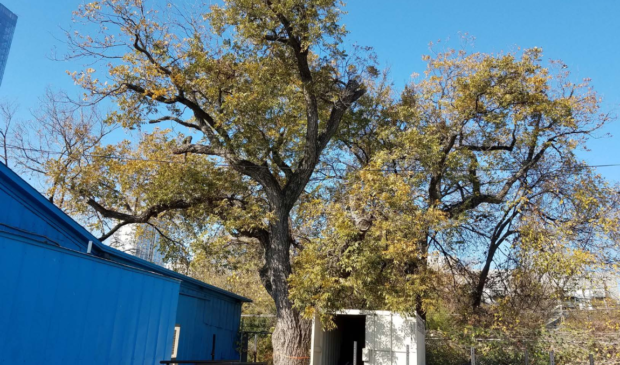Citing historical lessons, Environmental Commission opts for mitigation rather than preservation
Monday, September 10, 2018 by
Jessi Devenyns It’s not often that a variance to remove heritage trees comes before the Environmental Commission. But when it does, the decision is no walk in the park.
“Trees like this are one of the challenging cases for us,” City Arborist Keith Mars said at the Sept. 5 meeting of the commission. He acknowledged that it is no easy task to decide if a 37.5-inch pecan tree and a 34-inch American elm are more valuable to the city’s urban forest than the dozens of trees that would be put in place post-construction to mitigate their removal.
In this particular case at 710 E. Third St., his opinion is that it is worth it. Both trees, he explained, are in poor health and “due to these conditions, these trees are unlikely to survive code-compliant construction.”
However, even with the city arborist advocating the removal of the trees, the commissioners had difficulty accepting that they are in such a bad state that they need to be removed. Several commissioners suggested that, rather than for health reasons, the applicant wishes to remove the trees because their position is not amenable to the development’s designs. Designing around the trees would reduce the density of the development by a third.
“We’re saying the tree is less significant than their ability to put something in that space,” said Chair Linda Guerrero.
Stephen Drenner, the founding principal of the Drenner Group, who was speaking on behalf of the applicant KBGE Engineering, noted, “Asking for a removal of a 30-plus-inch tree is not something we do lightly.” However, he explained that their plans to remove the trees are in line with the city’s larger plan. He exhibited a rendering of the Waller Creek improvement plans that reflected the removal of the pecan tree in question, and he said that the American elm on Fourth Street will also be removed as a part of the expansion of the Lance Armstrong Bikeway.
“If these trees are to be lost anyway … wouldn’t we be better off doing as good as we could do from a mitigation standpoint?” Drenner said.
Despite his arguments, Commissioner Marisa Perales noted that developments cannot mitigate their way into compliance with the heritage tree ordinance. She also said that the applicants were discussing mitigation before they determined if the trees can be saved.
Mars explained that although the trees are no imminent hazard, “any development that comes in would reasonably expect to remove the trees.” With this reality staring the commission in the face, Mars suggested that they choose the $21,450 of mitigation money offered from private funds, rather than risking development around the trees only to have them die and then have to produce mitigation funds out of public coffers.
Commissioner Katie Coyne agreed with the arborist’s assessment, saying that this is not the first time the commissioners have been asked to roll the dice on a mitigation offer – and last time they chose wrongly. “Previously we have seen when we do not recommend for approval … we’ve gotten less in the long run,” she said. Many commissioners expressed their agreement with this statement.
Guerrero suggested that this was not a black-and-white case. She offered a compromise in the form of a motion to save the pecan tree and authorizing the removal of the elm. “People like second chances in life. That tree (the pecan) would like that second chance,” she said.
Even with her compromise on the table and a second for her motion, Commissioner Wendy Gordon amended the motion to authorize the removal of both trees. “Unfortunately, wishful thinking will not make that tree healthier,” Gordon offered as an explanation.
The motion to recommend the removal of both heritage trees off the property passed, with commissioners Peggy Maceo and Marisa Perales joining Guerrero to vote against it and Commissioner Pam Thompson off the dais.
Photo courtesy of the city of Austin.
The Austin Monitor’s work is made possible by donations from the community. Though our reporting covers donors from time to time, we are careful to keep business and editorial efforts separate while maintaining transparency. A complete list of donors is available here, and our code of ethics is explained here.
You're a community leader
And we’re honored you look to us for serious, in-depth news. You know a strong community needs local and dedicated watchdog reporting. We’re here for you and that won’t change. Now will you take the powerful next step and support our nonprofit news organization?








